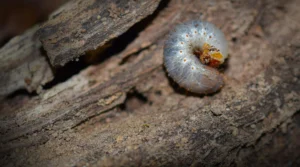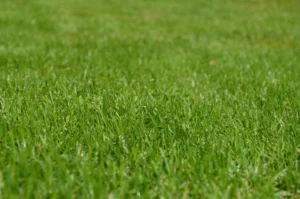All About Grubs & How to Prevent Them
From Early Signs to Long-Term Solutions
Have you ever uncovered a white, curled-up larva while digging in your yard? Chances are, you’ve encountered a grub. These subterranean pests can wreak havoc on your lawn, often going unnoticed until significant damage has occurred.
Grubs are the immature stage of various beetles in Alabama, including Japanese beetles, June bugs, and European chafers. They reside beneath the soil surface, feeding on the roots of grasses and other plants.
If left unchecked, grubs can cause extensive lawn damage. Continue reading to learn more about these pests and effective prevention strategies from a local lawn care service in Robertsdale, AL.

Understanding the Grub Lifecycle
Effective grub control begins with understanding their life stages:
- Egg Stage: During the summer, adult beetles lay eggs in moist, well-irrigated lawns.
- Larval Stage: Upon hatching, grubs begin feeding on grass roots, causing the most damage during this phase.
- Overwintering: As temperatures drop, grubs burrow deeper into the soil to survive the winter months.
- Pupation and Emergence: In spring, grubs move closer to the surface, eventually maturing into adult beetles, thus restarting the cycle.
Since the larval stage is when grubs are most destructive, timely intervention is crucial.
How Grubs Harm Your Lawn
Grubs feed on grass roots, weakening the plant’s ability to absorb water and nutrients. This damage manifests in several ways:
- Brown Patches: Irregularly shaped dead spots may appear, especially in late summer or early fall.
- Spongy Turf: Affected grass may feel soft underfoot and can be easily lifted due to root damage.
- Increased Wildlife Activity: Animals like birds, skunks, and raccoons may dig up your lawn in search of grubs, exacerbating the damage.
- Drought Symptoms: Even with adequate watering, grass may wilt or die because of compromised roots.
Why Grub Damage Escalates
Grub infestations can worsen over time as adult beetles return annually to lay more eggs, increasing the grub population. Without intervention, your lawn may suffer extensive damage, potentially requiring costly reseeding or sod replacement.
Confirming a Grub Infestation
To determine if grubs are the culprit behind your lawn issues:
- Inspect Affected Areas: Choose a section of your lawn exhibiting brown or spongy patches.
- Dig a Sample: Use a shovel to remove a one-foot square of turf about 2–3 inches deep.
- Examine the Soil: Look for white, C-shaped larvae.
Finding any grubs in your lawn indicates a significant infestation that requires prompt treatment.

Preventing Grub Infestations
Maintaining a healthy lawn is your best defense against grubs:
-
- Lawn Care Practices:
- Mow at a height of 3–4 inches to promote deep root growth.
- Water deeply but infrequently to discourage beetles from laying eggs.
- Apply balanced fertilizers to strengthen grass resilience.
- Aeration: Alleviate soil compaction through core or liquid aeration, enhancing root health and disrupting grub habitats.
- Overseeding: Introduce robust grass varieties to create a dense turf that resists grub colonization.
- Lawn Care Practices:
- Encourage Natural Predators: Attract birds and beneficial insects that feed on grubs, providing natural pest control.
Treatment Options for Grub Infestations in AL
If prevention isn’t enough, consider these treatment methods:
Chemical Treatments
- Preventive Insecticides: Apply in early summer to target young grubs before they cause damage.
- Curative Insecticides: Use in late summer or early fall to eliminate existing grubs.
Eco-Friendly Solutions
-
- Beneficial Nematodes: Microscopic worms that parasitize and kill grubs; apply in warm, moist soil conditions.
- Milky Spore: A bacterium that specifically targets Japanese beetle grubs; offers long-term control but takes time to establish.
- Neem Oil: A natural insecticide that disrupts grub development; best for minor infestations.
Signs of Successful Treatment
Post-treatment, monitor your lawn for:
- Reduced Animal Activity: Fewer signs of digging indicate a decline in grub population.
- Grass Recovery: Brown patches begin to green up and regrow.
- Improved Turf Firmness: Grass feels more secure underfoot, indicating root recovery.
If issues persist, a follow-up treatment may be necessary.
Long-Term Grub Prevention Strategies
Implement these practices to keep grubs at bay in the South:
- Annual Aeration: Maintain soil health and reduce compaction.
- Smart Watering: Avoid overwatering, especially during beetle egg-laying season.
- Seasonal Fertilization. Strengthens grass against pests.
- Regular Inspections. Check for early signs each summer.
What If You Ignore Grubs?
Disregarding those pesky grubs in your lawn can lead to:
- Complete lawn death. Requiring expensive sod replacement.
- Weed infestations. Bare spots invite common weeds that are difficult to eradicate.
- Animal damage. Digging animals create unsightly holes in your yard.
Keep in mind that prevention is always more affordable than a total lawn redo!
Act Now to Protect Your Lawn
Grubs won’t disappear without any action. Proactive measures are a must because early intervention saves time and money.
So don’t wait until your lawn is destroyed! Start grub prevention today and enjoy a lush, healthy yard year-round.
Contact your local pest care experts at TDI Services. We’re your trusted provider for lawn care and pest control services in Robertsdale, AL and the surrounding areas.
Reach out to learn about our customized plans to keep your lawn grub-free. Call us now!
